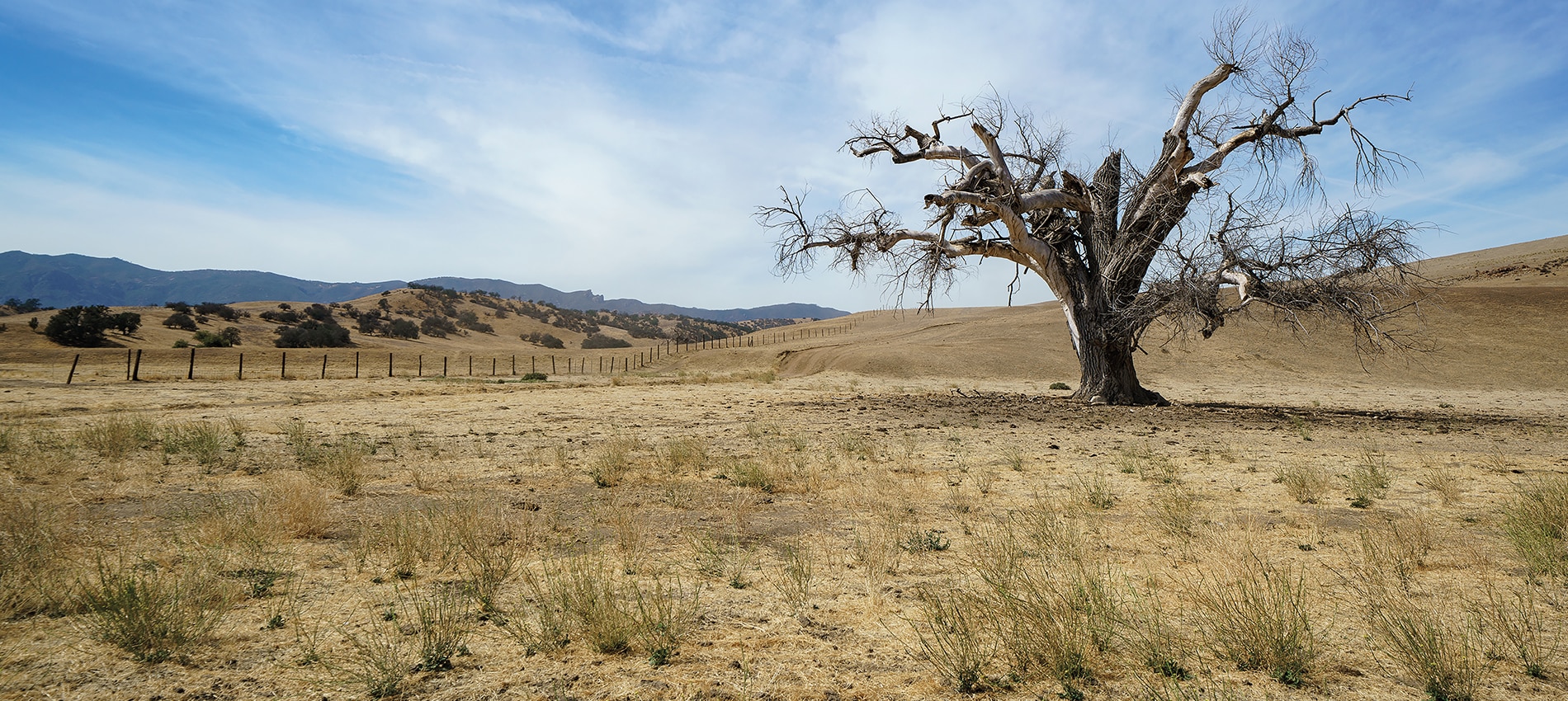
This article is featured in the Spring 2022 issue of LAND magazine. Click here to find out more.
According to the most recent Census of Agriculture conducted by the US Department of Agriculture, California accounts for 11 percent of the nation’s total agricultural sales. The state’s bounty includes dairy products, beef, produce such as lettuce, tomatoes and strawberries, as well as high-value specialties such as almonds, walnuts, pistachios, and grapes. By volume, California provides one-third of the nation’s vegetables and two-thirds of its nuts.
Drought conditions decrease crop yields. Some of America’s staples such as corn, soybeans, rice, dairy and meat, as well as favorites such as almonds and avocados are particularly susceptible. When these foods become scarce, supermarket prices will skyrocket.
If drought conditions do not subside, experts predict that California is projected to lose more than one-tenth of its usable acreage by 2040. While that is dire, it doesn’t mean that Californians will be out of the agriculture business, but it likely means the state’s agriculture business will change.
As farmers are forced to shut down portions of their productive land and face water shortages, they will have to focus on profit versus consumer demand. As water becomes scarcer and more expensive, producers must allocate it to crops that deliver higher profits, in order to keep their operations afloat.
Tree crops like almonds, avocados, peaches, citrus, and others are among the most profitable per drop of water. While these high-value items may become more plentiful, the variety of commodities that California brings to the nation will likely decrease.
To further complicate the situation, the state’s cities continue to sprawl, prompting working land to be converted to commercial and residential holdings and increasing the demand (and competition) for water.
The Situation at Hand
Since 2000, more than half of the state’s water years have been dry or drought years. The 2021 water year was California’s driest in a century. One result of the record-breaking heat and dryness was a devastating fire season where more than two and a half million acres and thousands of homes burned.
According to the National Integrated Drought Information System, 99 percent of the state is currently experiencing a moderate drought. Of that, more than 66 percent of the Golden State is in a severe drought.
On the landscape, a severe drought means:
- Grazing land is inadequate.
- Fire season is longer with dry fuels, high burn intensity, and a large fire spatial extent (“footprint”)
- Trees are stressed.
- Plants increase reproductive mechanisms as they try to survive.
- Wildlife diseases and mortality increase.
The effects of a moderate drought include:
- Dryland pasture growth is stunted, required supplemental feeding for livestock.
- Landscaping, gardens and cropland need irrigation earlier.
- Wildlife movement patterns begin to change.
- Stock ponds and creeks are lower than usual.
All of the state’s 58 counties are under a drought emergency proclamation, and as of January 18, reservoir levels have dropped to 2019 levels. A wet and snow-packed December ending 2021 temporarily improved conditions across the state, but a dry January cut into those gains. According to California’s Drought Update, it would take 140 percent of the state’ normal yearly rainfall to recover from drought.
Californians are being asked to reduce their water use by an additional 15 percent over 2020 levels to help protect water reserves and maintain critical flows for fish and wildlife wherever possible. (In 2021, low river levels prompted state officials to truck young salmon from the Central Valley to the Pacific Ocean.) Wasteful water practices, such as using decorative fountains, lakes and ponds, and watering landscapes, have been banned.
Down on the Farm and Ranch
While all Californians are feeling the drought’s impacts, farmers and ranchers are bearing the brunt. In the face of water shortages, state and federal agencies have cut water deliveries to farmers and ranchers drastically—sometimes cutting off water supplies completely.
As reported by Cal Matters, agriculturists are responding to the challenges in three intertwined ways: suspending cultivation of some fields or ripping up orchards for lack of water, drilling new wells to tap into diminishing aquifers, and buying water from those who have it.
Each response delivers an economic impact. Some farmers and ranchers, especially small family operators, are forced out of business, which accelerates the shift to large-scale corporate agribusinesses that have financial resources to cope. The types of crops that can be grown profitably is changing. And the semi-secretive water market is being super-charged by demand.
As farmers and ranchers are losing their land and livestock, farm workers are losing their jobs, and the tremors continue through the economy.
In the Long-term
Agriculture in California—and across the nation—is essential to our nation’s well-being, security and sustainability. In order to keep California producing the food that nourishes our bodies and our economy, it is crucial that we work together to preserve the farm and ranch land we have and make sure that it keeps working in the future.
That’s where land conservation organizations, such as the California Farmland Trust and The Wildlands Conservancy, come in. Conservation organizations work with willing farmers and ranchers who want to ensure that their land remains productive croplands or rangelands in the future. The owner and land trust team cooperate to enact easements, legal documents that dictate the use of the land in perpetuity. The landowner either donates or sells the development rights associated with the property, ensuring that it remains intact, open, working land instead of the site of a shopping center or sub-division.
Ultimately, the goal extends beyond conservation to appreciation. California’s rich land is a life-sustaining natural resource that should be valued and safeguarded—for the good of the state and our great nation.
Final Thoughts
“The impacts of California’s ongoing drought extends far beyond our borders, and should serve as a wake-up call for the entire nation,” said Pete Clark, a fifth generation California rancher and Real Estate Broker of Clark Company. “Productive land and its bounty is the backbone of our nation’s health, wealth and security. ”
“With that in mind, it is incumbent that everyone understand the relevance of agriculture to our daily lives and measure its value in ecological terms as well as market terms. We must conserve agricultural lands’ powerful productivity if we are not only going to survive, but thrive in the 21st Century.”
“California’s rich land is a life-sustaining natural resource that should be valued and safeguarded”
Clark Company
While the following water-saving tips were created to help Californians stretch dwindling water supplies, they make sense for anyone interested in conservation. Small savings multiplied by great numbers of people equal a big impact.
Indoor Water Conservation Tips
⟶ Bathroom
- Avoid flushing the toilet unnecessarily.
- Dispose of tissues, insects and other similar waste in the trash rather than the toilet.
- Take short showers instead of baths. Turn on the water only to get wet and lather and then again to rinse off.
- Avoid letting the water run while brushing your teeth, washing your face or shaving.
⟶ Kitchen
- Operate automatic dishwashers only when they are fully loaded. Use the “light wash” feature to use less water.
- Hand wash dishes by filling two containers—one with soapy water and the other with rinse water containing a small amount of chlorine bleach
- Clean vegetables in a pan filled with water rather than running water from the tap.
- Avoid wasting water waiting for it to get hot. Capture it for other uses such as plant watering or heat it on the stove or in a microwave.
- Don’t rinse dishes before placing them in the dishwasher, just remove large particles of food.
- Avoid using running water to thaw meat or other frozen foods. Defrost food overnight in the refrigerator or use the defrost setting on your microwave.
⟶ Laundry
- Operate clothes washers only when they are fully loaded or set the water level for the size of your load.
Outdoor Water Conservation Tips
⟶ Lawn Care
- A heavy rain eliminates the need for watering for up to two weeks. Most of the year, lawns only need one inch of water per week.
- Capture rainwater and/or greywater for irrigation purposes like watering your plants and lawn.
- Check the soil moisture levels with a soil probe, spade or large screwdriver.
- You don’t need to water if the soil is still moist. If your grass springs back when you step on it, it doesn’t need water yet.
- If your lawn does require watering, do so early in the morning or later in the evening, when temperatures are cooler.
- Water in several short sessions rather than one long one, in order for your lawn to better absorb moisture and avoid runoff.
- Use a broom or blower instead of a hose to clean leaves and other debris from your driveway or sidewalk.
- Avoid leaving sprinklers or hoses unattended. A garden hose can pour out 600 gallons or more in only a few hours.
- In extreme drought, allow lawns to die in favor of preserving trees and large shrubs.
⟶ Car Washing
- Use a commercial car wash that recycles water.
- If you wash your own car, use a shut-off nozzle that can be adjusted down to a fine spray on your hose.
Regardless of the location, limiting residential water use, means more water is available in the local aquifers for agricultural use. And if you want to make a direct impact on farmers’ and ranchers’ pocketbooks, buy meat, fruits and vegetables from a local Farmer’s Market.
